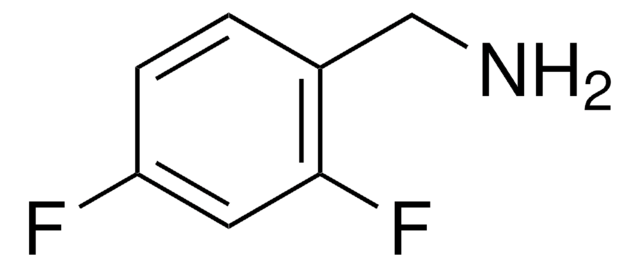All Photos(1)
About This Item
Linear Formula:
F2C6H3CH2NH2
CAS Number:
Molecular Weight:
143.13
MDL number:
UNSPSC Code:
12352100
PubChem Substance ID:
NACRES:
NA.22
Recommended Products
Assay
96%
refractive index
n20/D 1.491 (lit.)
bp
184 °C (lit.)
density
1.21 g/mL at 25 °C (lit.)
SMILES string
NCc1cc(F)cc(F)c1
InChI
1S/C7H7F2N/c8-6-1-5(4-10)2-7(9)3-6/h1-3H,4,10H2
InChI key
VJNGGOMRUHYAMC-UHFFFAOYSA-N
Application
3,5-Difluorobenzylamine (DFBA) has been used as a derivatization reagent in the following studies:
- Determination of epichlorohydrin (ECH) in water by GC/MS analysis in selected ion monitoring (SIM) mode.
- Analysis of the epoxides 1,2-epoxybutane, epichlorohydrin, and epifluorohydrin in water by GC/MS analysis.
- Estimation of ECH in water by on-line solid-phase extraction (SPE) coupled to liquid chromatography/electrospray ionization tandem mass spectrometry (LC/ESI-MS/MS) using a triple quadrupole mass spectrometer.
Signal Word
Danger
Hazard Statements
Precautionary Statements
Hazard Classifications
Skin Corr. 1B
Storage Class Code
8A - Combustible corrosive hazardous materials
WGK
WGK 3
Flash Point(F)
165.2 °F - closed cup
Flash Point(C)
74 °C - closed cup
Personal Protective Equipment
dust mask type N95 (US), Eyeshields, Gloves
Certificates of Analysis (COA)
Search for Certificates of Analysis (COA) by entering the products Lot/Batch Number. Lot and Batch Numbers can be found on a product’s label following the words ‘Lot’ or ‘Batch’.
Already Own This Product?
Find documentation for the products that you have recently purchased in the Document Library.
Cristina Ripollés et al.
Rapid communications in mass spectrometry : RCM, 23(12), 1841-1848 (2009-05-15)
A new sensitive and selective method based on on-line solid-phase extraction (SPE) coupled to liquid chromatography/electrospray ionization tandem mass spectrometry (LC/ESI-MS/MS) using a triple quadrupole mass spectrometer has been developed for the determination of epichlorohydrin (ECH) in different types of
Stuart J Khan et al.
Analytical chemistry, 78(8), 2608-2616 (2006-04-18)
Trace concentrations of small soluble epoxides are suspected byproducts of drinking water ozonation. However, adequate characterization of epoxide formation is currently limited by the lack of suitable analytical methods to target these chemicals in dilute, but complex aqueous solutions. One
Our team of scientists has experience in all areas of research including Life Science, Material Science, Chemical Synthesis, Chromatography, Analytical and many others.
Contact Technical Service









